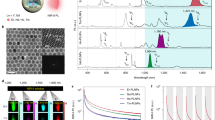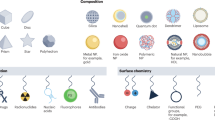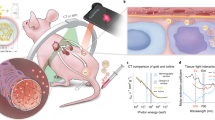Abstract
There is a need for safer and improved methods for non-invasive imaging of the gastrointestinal tract. Modalities based on X-ray radiation, magnetic resonance and ultrasound suffer from limitations with respect to safety, accessibility or lack of adequate contrast. Functional intestinal imaging of dynamic gut processes has not been practical using existing approaches. Here, we report the development of a family of nanoparticles that can withstand the harsh conditions of the stomach and intestine, avoid systemic absorption, and provide good optical contrast for photoacoustic imaging. The hydrophobicity of naphthalocyanine dyes was exploited to generate purified ∼20 nm frozen micelles, which we call nanonaps, with tunable and large near-infrared absorption values (>1,000). Unlike conventional chromophores, nanonaps exhibit non-shifting spectra at ultrahigh optical densities and, following oral administration in mice, passed safely through the gastrointestinal tract. Non-invasive, non-ionizing photoacoustic techniques were used to visualize nanonap intestinal distribution with low background and remarkable resolution, and enabled real-time intestinal functional imaging with ultrasound co-registration. Positron emission tomography following seamless nanonap radiolabelling allowed complementary whole-body imaging.
This is a preview of subscription content, access via your institution
Access options
Subscribe to this journal
Receive 12 print issues and online access
$259.00 per year
only $21.58 per issue
Buy this article
- Purchase on Springer Link
- Instant access to full article PDF
Prices may be subject to local taxes which are calculated during checkout






Similar content being viewed by others
References
Everhart, J. E. & Ruhl, C. E. Burden of digestive diseases in the United States part I: overall and upper gastrointestinal diseases. Gastroenterology 136, 376–386 (2009).
Dye, C. E., Gaffney, R. R., Dykes, T. M. & Moyer, M. T. Endoscopic and radiographic evaluation of the small bowel in 2012. Am. J. Med. 125, 1228.e1–1228.e12 (2012).
Husebye, E. Gastrointestinal motility disorders and bacterial overgrowth. J. Intern. Med. 237, 419–427 (1995).
Soffer, E. E. Small bowel motility: ready for prime time? Curr. Gastroenterol. Rep. 2, 364–369 (2000).
Bassotti, G. et al. Gastrointestinal motility disorders in inflammatory bowel diseases. World J. Gastroenterol. 20, 37–44 (2014).
Lembo, A. & Camilleri, M. Chronic constipation. N. Engl. J. Med. 349, 1360–1368 (2003).
Shafer, R. B., Prentiss, R. A. & Bond, J. H. Gastrointestinal transit in thyroid disease. Gastroenterology 86, 852–855 (1984).
Abrahamsson, H. Gastrointestinal motility disorders in patients with diabetes mellitus. J. Intern. Med. 237, 403–409 (1995).
Jost, W. H. Gastrointestinal motility problems in patients with Parkinson's disease. Drugs Aging 10, 249–258 (1997).
Kim, C., Favazza, C. & Wang, L. V. In vivo photoacoustic tomography of chemicals: high-resolution functional and molecular optical imaging at new depths. Chem. Rev. 110, 2756–2782 (2010).
Ke, H., Erpelding, T. N., Jankovic, L., Liu, C. & Wang, L. V. Performance characterization of an integrated ultrasound, photoacoustic, and thermoacoustic imaging system. J. Biomed. Opt. 17, 056010 (2012).
Ntziachristos, V., Ripoll, J., Wang, L. V. & Weissleder, R. Looking and listening to light: the evolution of whole-body photonic imaging. Nature Biotechnol. 23, 313–320 (2005).
Emelianov, S. Y., Li, P. C. & O'Donnell, M. Photoacoustics for molecular imaging and therapy. Phys. Today 62, 34–39 (May, 2009).
Stuart, S. et al. The smaller bowel: imaging the small bowel in paediatric Crohn's disease. Postgrad. Med. J. 87, 288–297 (2011).
Luke, G. P., Yeager, D. & Emelianov, S. Y. Biomedical applications of photoacoustic imaging with exogenous contrast agents. Ann. Biomed. Eng. 40, 422–437 (2012).
De la Zerda, A., Kim, J. W., Galanzha, E. I., Gambhir, S. S. & Zharov, V. P. Advanced contrast nanoagents for photoacoustic molecular imaging, cytometry, blood test and photothermal theranostics. Contrast Media Mol. Imaging 6, 346–369 (2011).
Zhang, W. et al. Synthesis and characterization of thermally responsive pluronic F127−chitosan nanocapsules for controlled release and intracellular delivery of small molecules. ACS Nano 4, 6747–6759 (2010).
Tetko, I. V. & Tanchuk, V. Y. Application of associative neural networks for prediction of lipophilicity in ALOGPS 2.1 program. J. Chem. Inf. Comput. Sci. 42, 1136–1145 (2002).
Lin, Y. & Alexandridis, P. Temperature-dependent adsorption of pluronic F127 block copolymers onto carbon black particles dispersed in aqueous media. J. Phys. Chem. B 106, 10834–10844 (2002).
Chandaroy, P., Sen, A., Alexandridis, P. & Hui, S. W. Utilizing temperature-sensitive association of pluronic F-127 with lipid bilayers to control liposome-cell adhesion. Biochim. Biophys. Acta Biomembr. 1559, 32–42 (2002).
Ahmed, F., Alexandridis, P. & Neelamegham, S. Synthesis and application of fluorescein-labeled pluronic block copolymers to the study of polymer–surface interactions. Langmuir 17, 537–546 (2001).
Phipps, J. S., Richardson, R. M., Cosgrove, T. & Eaglesham, A. Neutron reflection studies of copolymers at the hexane/water interface. Langmuir 9, 3530–3537 (1993).
Mallidi, S. et al. Multiwavelength photoacoustic imaging and plasmon resonance coupling of gold nanoparticles for selective detection of cancer. Nano Lett. 9, 2825–2831 (2009).
De la Zerda, A. et al. Family of enhanced photoacoustic imaging agents for high-sensitivity and multiplexing studies in living mice. ACS Nano 6, 4694–4701 (2012).
Bayer, C. L., Nam, S. Y., Chen, Y. S. & Emelianov, S. Y. Photoacoustic signal amplification through plasmonic nanoparticle aggregation. J. Biomed. Opt. 18, 016001 (2013).
Lovell, J. F. et al. Porphysome nanovesicles generated by porphyrin bilayers for use as multimodal biophotonic contrast agents. Nature Mater. 10, 324–332 (2011).
Jain, P. K., Lee, K. S., El-Sayed, I. H. & El-Sayed, M. A. Calculated absorption and scattering properties of gold nanoparticles of different size, shape, and composition: applications in biological imaging and biomedicine. J. Phys. Chem. B 110, 7238–7248 (2006).
Carino, G. P. & Mathiowitz, E. Oral insulin delivery. Adv. Drug Deliv. Rev. 35, 249–257 (1999).
Pu, K. et al. Semiconducting polymer nanoparticles as photoacoustic molecular imaging probes in living mice. Nature Nanotech. 9, 233–239 (2014).
Malmsten, M., Emoto, K. & Van Alstine, J. M. Effect of chain density on inhibition of protein adsorption by poly(ethylene glycol) based coatings. J. Colloid Interface Sci. 202, 507–517 (1998).
Kwon, S. & Sevick-Muraca, E. M. Non-invasive, dynamic imaging of murine intestinal motility. Neurogastroenterol. Motil. 23, 881–e344 (2011).
Gittes, G. K., Nelson, M. T., Debas, H. T. & Mulvihill, S. J. Improvement in survival of mice with proximal small bowel obstruction treated with octreotide. Am. J. Surg. 163, 231–233 (1992).
Ali, H. & van Lier, J. E. Metal complexes as photo- and radiosensitizers. Chem. Rev. 99, 2379–2450 (1999).
Liu, T. W., MacDonald, T. D., Shi, J., Wilson, B. C. & Zheng, G. Intrinsically copper-64-labeled organic nanoparticles as radiotracers. Angew. Chem. Int. Ed. 51, 13128–13131 (2012).
Acknowledgements
The authors thank L.L. Balos for assistance with histology, C. Cheng for assistance with dynamic light scattering measurements, and E. Huynh and G. Zheng for assistance with photoacoustic spectroscopy. This work was supported by the National Institutes of Health (W.C., R01CA169365; J.F.L., DP5OD017898; M.S., S10OD010393), the Department of Defense (W.C., W81XWH-11-1-0644), the Korean Ministry of Science, ICT and Future Planning (IT Consilience Creative Program; C.K. and J.F.L., NIPA-2013-H0203-13-1001; C.K., NRF-2011-0030075) and a SUNY Research Foundation Collaboration Fund grant.
Author information
Authors and Affiliations
Contributions
Yu.Z. and J.F.L. conceived the project. Yu.Z, M.J., L.J.R., H.H. and J.G. were responsible for most data collection. Yu.Z., P.A. and J.F.L. planned experiments and interpreted the data related to nanonap formulation. H.H., Yi.Z., S.S., T.E.B. and W.C. planned experiments and interpreted the data related to nanonap radiolabelling. Yu.Z., M.J., L.J.R., J.D.H., M.S., C.K. and J.F.L. planned experiments and interpreted the data related to photoacoustic imaging. Yu.Z., J.G. and J.F.L. planned toxicity studies and interpreted the data. Yu.Z., M.J., H.H., J.D.H., W.C., C.K. and J.F.L. wrote the manuscript.
Corresponding authors
Ethics declarations
Competing interests
The authors declare no competing financial interests.
Supplementary information
Supplementary information
Supplementary Information (PDF 2030 kb)
Supplementary Movie 1
Supplementary Movie 1 (AVI 16835 kb)
Supplementary Movie 2
Supplementary Movie 2 (AVI 1383 kb)
Rights and permissions
About this article
Cite this article
Zhang, Y., Jeon, M., Rich, L. et al. Non-invasive multimodal functional imaging of the intestine with frozen micellar naphthalocyanines. Nature Nanotech 9, 631–638 (2014). https://doi.org/10.1038/nnano.2014.130
Received:
Accepted:
Published:
Issue Date:
DOI: https://doi.org/10.1038/nnano.2014.130
This article is cited by
-
Radiolabeled nanomaterial for cancer diagnostics and therapeutics: principles and concepts
Cancer Nanotechnology (2023)
-
Achieving safe and high-performance gastrointestinal tract spectral CT imaging with small-molecule lanthanide complex
Biomaterials Research (2023)
-
Review of the role of ionic liquids in two-dimensional materials
Frontiers of Physics (2023)
-
Dual-targeting nanozyme for tumor activatable photo-chemodynamic theranostics
Journal of Nanobiotechnology (2022)
-
In vivo three-dimensional multispectral photoacoustic imaging of dual enzyme-driven cyclic cascade reaction for tumor catalytic therapy
Nature Communications (2022)



